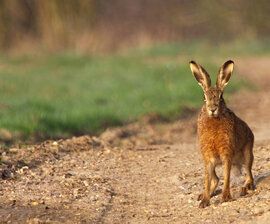Reports of "mad March hares", chasing each other and boxing, is always a welcome sign that spring is not far away. But don't let the sight of these animals cavorting in fields fool you, the hare population has decreased by 80% over the last century and it's about time that they were afforded the protection they truly deserve.

From a population of around four million in 1880 in England, a National Hare Survey undertaken in 1991-1993 revealed a figure of just 817,500 animals.
This dramatic decrease was recognised by government in 1995 when brown hares were listed on the "Short List of Globally Threatened/Declining Species" along with eight other mammals including the water vole, European otter, dormouse and red squirrel, in the first UK Biodiversity Action Plan. A Species Action Plan specially created for the brown hare in 1995 had the stated aim of doubling springtime numbers by 2010.
Yet, despite actions promoted by Natural England and undertaken by many hare-friendly farmers, Environment Minister Richard Benyon admitted in June 2011 that the government's target had not been achieved. According to the most recently published ten-year trend figures (for the period to 2007), from the Joint Nature Conservation Committee's Tracking Mammal Partnership, there has been "No statistically significant change" in brown hare numbers during that period.
The failure of the Species Action Plan for brown hares is a terrible blow for one of Britain's much loved, although most persecuted, creatures. Surprisingly, given its century-long population decline, it is still legal to kill hares in England during their breeding season.
Hares generally give birth and nurse their offspring, or leverets, from February onwards, producing on average two or three young in each of three litters spread across the spring and summer months.

Research undertaken in Norfolk found that by February of the survey year, 65 percent of sampled female hares were pregnant and, by the end of that month, 50 percent had given birth to their first litter and were nursing dependent young. The loss of pregnant or nursing mothers during the breeding season, through poaching, coursing or shooting, can have a serious effect on the number of leverets that survive to maturity.
Enhancing hare survival, particularly for leverets, was identified as a "specific target for conservation action" in a report by the Central Science Laboratory to Department for Environment, Food and Rural Affairs in 2004.
One important way to assist survival rates is to ensure that dependent young receive sustenance from their mothers until they are fully weaned.
The welfare issues associated with the killing of nursing females and the subsequent starvation of the dependent young were recognised most recently in Scotland, with the introduction of a close season for hares. The 2011 Wildlife and Natural Environment Act makes it an offence to "intentionally or recklessly kill, injure or take" brown hares during their breeding season from February to September, and mountain hares from March to July. Indeed, much of mainland Europe already has similar legislation in place, and the Game Preservation Act of Northern Ireland made it an offence "wilfully to take, kill or destroy" hares during the close season in 1928.
So what about hares in England? Well, the 1892 Hares Preservation Act was introduced to allow "a close time for hares during the breeding season". Even then, the legislation noted that hares had "greatly decreased in numbers in England, Scotland, and Wales, by reason of their being inconsiderately slaughtered" and stated that "it is important to provide for their protection during the breeding season".
The Act bans the sale, but crucially not the killing, of non-imported hares and leverets from March to July. In addition, the 1880 Ground Game Act protects hares from being taken on moorland and unenclosed land from April to August, but gives no protection for hares on farmland.
It is clear that these pieces of fragmented 19th century legislation are in urgent need of modernisation.
With the governments Species Action Plan having failed to achieve its target, HSI UK urges that additional measures must now be taken to protect hares. In particular, dependent young, pregnant and nursing mothers should be protected at the earliest opportunity to encourage an increase in population.
Supported by more than 130 Members of Parliament, from all sides of the House of Commons, Early Day Motion 2531 calls on the government to protect hares during their breeding season. This would bring England in line with Scotland and most of the rest of Europe, and give hares the protection they so obviously need.
Urgent action is needed now if we are to ensure that "mad March Hares" are still around in good numbers to herald the arrival of spring for future generations.
And the boxing? It is not, as often assumed, two males, it's said to be a female seeing-off an amorous male.
For more information on hare protection and the work of Humane Society International/UK, visit www.hsiuk.org
Thanks to Andy Fisher for the use of his hare images.
